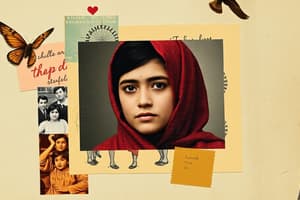Podcast
Questions and Answers
Within the context of Pashtunwali, how does the act of 'opening your door to a visitor' shape the dynamics of Malala's household, considering its impact on personal space and familial interactions?
Within the context of Pashtunwali, how does the act of 'opening your door to a visitor' shape the dynamics of Malala's household, considering its impact on personal space and familial interactions?
- It encourages a secluded environment where visitors are segregated based on gender, preserving traditional roles and minimizing potential conflicts.
- It necessitates strict adherence to predetermined schedules and routines to accommodate the needs of visitors while maintaining order within the household.
- It cultivates an environment of constant flux and communal living, where boundaries between personal and public spheres are intentionally blurred to strengthen social bonds. (correct)
- It fosters a rigid hierarchical structure where visitors are treated with formal deference, reinforcing social stratification within the community.
Considering Malala's observations of gendered spaces and interactions (men's guest room, women's veranda), how does her gravitation towards the 'weighty world of the men' reflect a subtle subversion of established cultural norms?
Considering Malala's observations of gendered spaces and interactions (men's guest room, women's veranda), how does her gravitation towards the 'weighty world of the men' reflect a subtle subversion of established cultural norms?
- It underscores her tacit acceptance of male dominance and reinforces the marginalization of women's voices and perspectives in political discourse.
- It represents a nuanced challenge to gendered expectations, signaling a desire to engage with consequential discussions and decision-making processes traditionally reserved for men. (correct)
- It highlights her conformity to prescribed gender roles, emphasizing the importance of seeking male approval and validation in pursuit of personal and social advancement.
- It signifies her active participation in maintaining traditional power structures by aligning herself with patriarchal authority figures and institutions.
Given the stark contrast between women observing purdah and those 'chatting casually – their faces radiant with freedom,' how does this juxtaposition serve to critique the socio-political constraints imposed upon women's autonomy and self-expression?
Given the stark contrast between women observing purdah and those 'chatting casually – their faces radiant with freedom,' how does this juxtaposition serve to critique the socio-political constraints imposed upon women's autonomy and self-expression?
- It reinforces the idea that women's liberation is contingent upon their physical appearance and conformity to Western beauty standards.
- It perpetuates the stereotype of women as passive recipients of patriarchal oppression, devoid of agency in resisting or challenging social norms.
- It minimizes the significance of cultural traditions and religious practices in shaping women's identities and experiences.
- It provides a comparative framework for evaluating the differential impacts of restrictive customs on women's emotional well-being and agency. (correct)
How can Malala’s early aversion to household chores, like 'chopping vegetables or cleaning dishes,' be interpreted as a micro-level resistance against traditional gender roles, considering the broader societal expectations placed on young girls?
How can Malala’s early aversion to household chores, like 'chopping vegetables or cleaning dishes,' be interpreted as a micro-level resistance against traditional gender roles, considering the broader societal expectations placed on young girls?
If 'living under wraps seemed so unfair – and uncomfortable,' what does this visceral reaction suggest about Malala's nascent understanding of bodily autonomy and the psychological implications of mandated concealment?
If 'living under wraps seemed so unfair – and uncomfortable,' what does this visceral reaction suggest about Malala's nascent understanding of bodily autonomy and the psychological implications of mandated concealment?
Given the spatial segregation within Malala's home (women on the veranda, men in the guest room), and considering the Pashtunwali code, how might this physical separation influence the development and transmission of cultural knowledge and values?
Given the spatial segregation within Malala's home (women on the veranda, men in the guest room), and considering the Pashtunwali code, how might this physical separation influence the development and transmission of cultural knowledge and values?
How does the narrative voice in this section of 'I Am Malala' function not merely as a recounting of personal experiences, but also as a subtle commentary on the intricacies of cultural identity formation within a specific socio-political context?
How does the narrative voice in this section of 'I Am Malala' function not merely as a recounting of personal experiences, but also as a subtle commentary on the intricacies of cultural identity formation within a specific socio-political context?
Considering the interplay between individual agency and societal expectations, how does Malala's declaration to her parents, 'no matter what,' function as a pivotal moment in her nascent journey towards self-discovery and social activism?
Considering the interplay between individual agency and societal expectations, how does Malala's declaration to her parents, 'no matter what,' function as a pivotal moment in her nascent journey towards self-discovery and social activism?
If we consider the act of 'tiptoe[ing] through the women's quarters' as a symbolic transgression of gendered boundaries, what does this spatial movement reveal about Malala's evolving understanding of power dynamics and social hierarchies?
If we consider the act of 'tiptoe[ing] through the women's quarters' as a symbolic transgression of gendered boundaries, what does this spatial movement reveal about Malala's evolving understanding of power dynamics and social hierarchies?
How does the author use sensory details—'gentle, confiding whispers,' 'tinkling laughter,' 'raucous, uproarious laughter'— to construct a rich tapestry of lived experiences within the women's world, and what does this contribute to the reader's understanding of the social fabric?
How does the author use sensory details—'gentle, confiding whispers,' 'tinkling laughter,' 'raucous, uproarious laughter'— to construct a rich tapestry of lived experiences within the women's world, and what does this contribute to the reader's understanding of the social fabric?
Flashcards
Pashtunwali Code
Pashtunwali Code
A traditional code of conduct among Pashtuns emphasizing hospitality and honor.
Hospitality
Hospitality
The act of generously welcoming and hosting guests.
Niqab
Niqab
A face-covering scarf worn by some Muslim women in public.
Burqa
Burqa
Signup and view all the flashcards
Purdah
Purdah
Signup and view all the flashcards
Men's Guest Room
Men's Guest Room
Signup and view all the flashcards
Women's Quarters
Women's Quarters
Signup and view all the flashcards
Children's Games
Children's Games
Signup and view all the flashcards
Symbolism of Freedom
Symbolism of Freedom
Signup and view all the flashcards
Cultural Observations
Cultural Observations
Signup and view all the flashcards
Study Notes
Malala's Childhood Observations
- Author describes a household filled with people, including neighbors, relatives, and many cousins.
- Describes the Pashtunwali code, emphasizing hospitality.
- Spends time with both men and women in separate areas of the house.
- Women gathered on the veranda, cooking, laughing, and talking.
- Men in the guest room, discussing politics.
- The author felt drawn to the men's world, but also fascinated by the women's world.
- Women's gatherings were different; gentle whispers and laughter, sometimes noisy.
- Women's headscarves and veils, often gone, with prominent use of lipstick and henna.
- Observed women's attire: some wore scarves, others burqas (long robes covering the head and face).
Customs and Traditions
- The concept of purdah, where women covered themselves in public.
- Different levels of covering: niqab (scarves), burqas (long robes).
- Women restricted to walking behind husbands, lowering their gaze when encountering men.
- Older girls disappearing behind veils as they mature.
Personal Reflections
- Describes the author's experience of the women's world as different from the men's world.
- Observation of women's freedom and casual interactions.
- Reflects on the concept of hiding and living under wraps, noting it as uncomfortable.
Studying That Suits You
Use AI to generate personalized quizzes and flashcards to suit your learning preferences.




